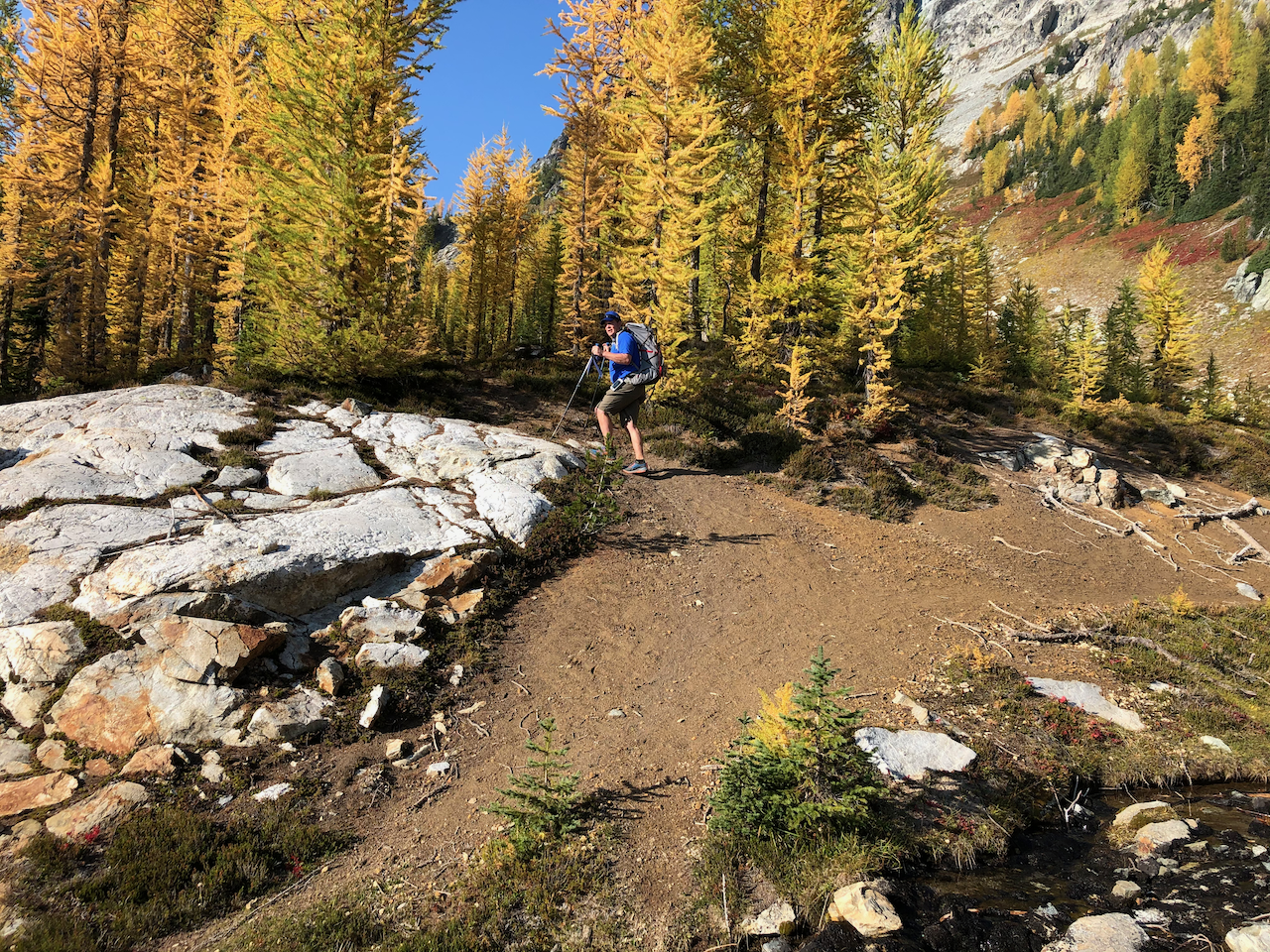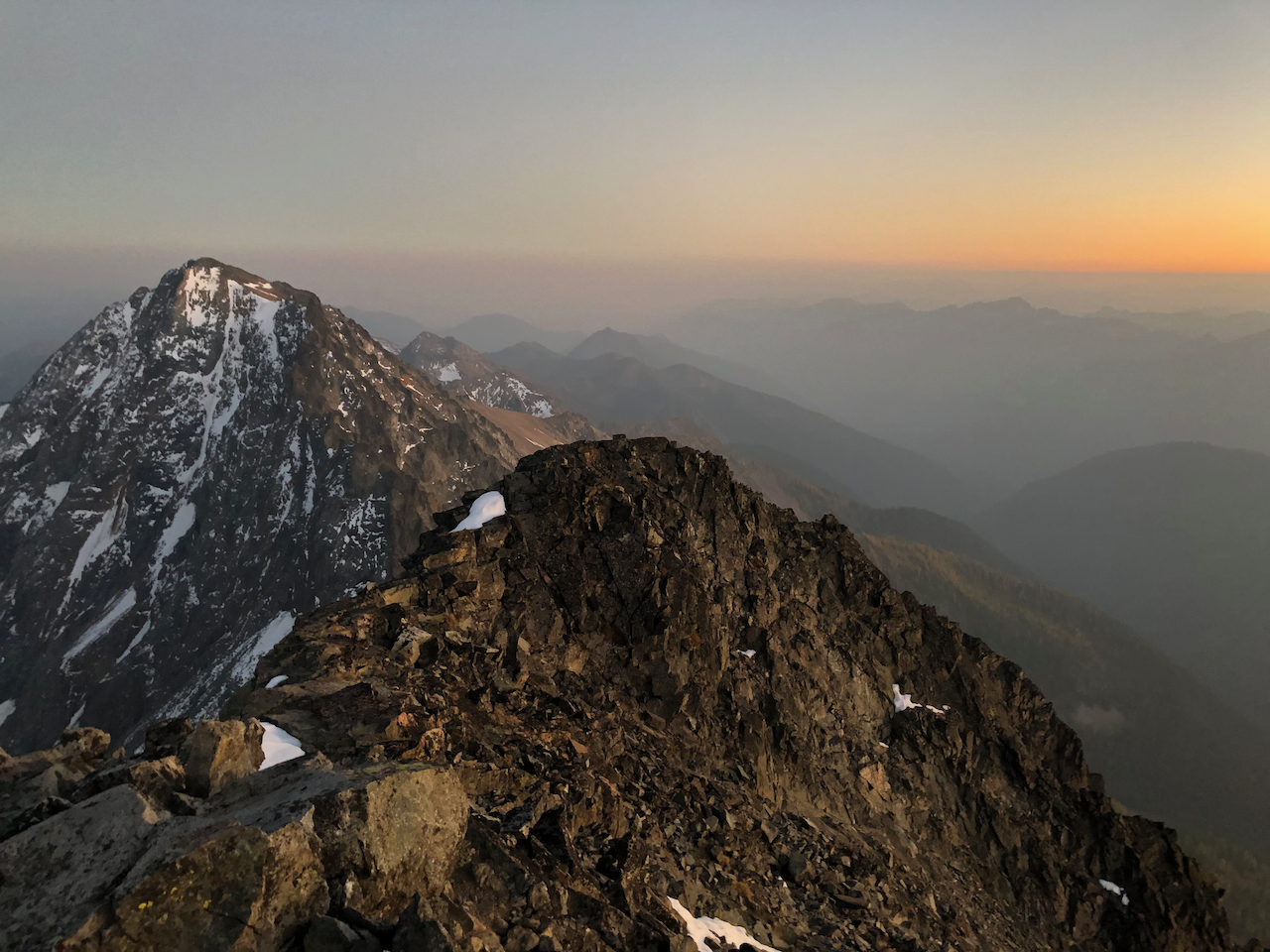Intro
kidzwonthike and I had been aspiring to visit Mt Maude and Seven Fingered Jack for a while (him for a few decades; me for a year) and we finally pulled the trigger this last week on an overnight starting on Friday. It was an epic mountaineering adventure full of a lot of fun scrambling, route finding, and a brilliant palette of fall colors: yellow larches, green heather, and red/yellow huckleberry bush leaves offsetting the brown (dirt/mud) and gray (granite/slate). Our route went was the clockwise loop from Phelps Creek Trail to Leroy Basin, traversing via Leroy Creek High Route and Carne Ridge High Route Mount to Carne Mountain and back to Phelps Creek Trail, visiting Seven Fingered Jack on Friday and Mount Maude on Saturday.
Road Conditions
I don't often say this, but I highly encourage folks to leave their low-clearance cars behind or choose a different approach to 7FJ, etc, due to the number of boulders embedded in the road; I kicked up 2 large boulders in my wheel well by accident on the way in going 15mph, and slowed my roll on the way out to avoid a repeat of the same issue.
It's a very long rough road (25 miles took about 1 hour).
We got there Friday and had to park down the road 0.1 miles. Get there early during peak season (it's sort of peak season still). We saw cars parked 0.5 miles down the road when we walked out last night (around 21:00).
Also: please, please, please be careful and leave space for others to pass. If you can barely squeeze a car through, that's a really good sign that you need to park somewhere else or push more off to the side (there were a few cars that forced me to slow down to ensure that I could carefully pass on both sides).
Phelps Creek Trail to Leroy Creek High Trail
The Phelps Creek Trail accesses a number of areas back in the Spider Gap, Buck Pass, and Cloudy Pass area, which leads into the PCT (K section) and is a long backdoor route to Glacier Peak, and the Suitattle area via Miner's Ridge (which is blocked from the frontdoor route due to the Downey Creek Fire).
So, expect to see lots of folks going to Leroy Basin and further, but given that the trail is stock rated up to Phelps Basin, the ability to social distance is best along here.
We ran into about 10 folks along the trail, all but 2 coming out.
Shortly after the big Leroy Creek washout one will need to turn right at the signage and go uphill.
Leroy Creek Trail to Leroy Basin
This trail is unmaintained and has many of the hallmarks of a climber's trail: steep ascents over short to nonexistent switchbacks. The number of blowdowns in this area was small, but non-zero.
The one thing that caught kidzwonthike and I off-guard was the fact that there were several non-dispersed campfire rings along the way up in the Glacier Peak Wilderness area :(.. Please, please, don't burn campfires up here folks! It's incredibly impactful and would be really hard to put out.
We got up to the basin, setup our camp really quickly (there were 6 or so established pads in the basin), then pushed up towards Seven Fingered Jack.
Leroy Creek High Trail to Seven Fingered Jack
We left camp late (around 15:00) and on the way up to 7FJ we crossed a creek at the Leroy Creek High Trail (right/west & south)/7FJ (left/east) junction, and filtered water since we had both drank quite a bit on the way up.
We went left to go uphill to 7FJ.
The "route" is easy to lose track of since there isn't a clear trail due to a lot of overgrown vegetation (those larches were sure tight in areas), blowdowns, etc, and sometimes the route goes over rock faces. If I were to do this route again with more time, I would either pick a low-impact time of year (early summer season), or do a lot more class 2/3 rock climbing up to the scree field. There was a lot of vegetation/moss with questionable stability and I discovered walking down the drainage was treacherous with all of the "rocker boulders" (I was trying to be less impactful with the heather).
Getting to the scree field was the hard part (who knew 400' could take 45 minutes?). After that we went up climber's left of the large col between North Maude Tower and the rightmost finger, as suggested by Beckey, Summitpost, etc, hugging the stable rock wall as much as possible; there's a whole lot of ballbearing quality scree up there and loose shale scree -- so be careful and mindful of other climbers as well as yourself.
This area felt similar to the scree scramble up to the base of the gully before ascending the rock wall at Del Campo or the summit pyramid at Shuksan.
As noted in the Beckey's scramble book and on Summitpost, there are other slightly more technical routes that could be leveraged (gully between the northernmost and second to northernmost finger), which might be easier and more pleasant to get up and down due to there being less loose scree.
After about 3 hours of climbing we finally got up to the summit at sunset. We quickly took some pictures, donned our helmets and headlamps, then headed back down.
Doing this again, I wouldn't climb up or down this mountain in the dark. It wasn't horrible, but we made some gaffes with some of the scree fields and had to do a lot of down scrambling (crab walk style), and went off-trail a few times after the scree field.
We got back to camp around 22:00, beaten and tired, made some food, and went to sleep around 23:00, with the almost full moon illuminating the basin with its light.
Leroy Basin to Ice Lakes Saddle via Leroy Creek High Route
This was a fun traverse with a fair number of ups and downs and some pretty large washouts. There were some minor areas where we got lost (mostly over washouts), but all-in-all it was fairly easy to follow if/when looking for the cairns.
The final ascent up to the saddle followed a few boot paths under the southwest rock face up to the saddle which were difficult to make out in the distance, but easy to follow up close.
Mount Maude from Ice Lakes Saddle
kidzwonthike and I stashed our gear at the saddle, then dropped in from the saddle to the lake basin. We continued following the northwest basin up to a boot path that was climber's left of a rock face immediately to the northwest of Upper Ice Lake.
From there it was scrambling up some class 2 scree to the ridge following a relatively clear boot path, then following the upper ridge to the summit.
The ridge walk is fairly straightforward up to the final crest. At the final crest one has a choice to go climber's left up a class 1 scramble/walk, or climber's right via a less stable class 2 scramble route. We opted for the climber's left path.
Had some summit snacks, petted some cute dogs, looked at the area, then went down the way we came up.
Got up to the saddle after playing hopscotch with some trail runners who gave us some potential beta on how to continue the rest of the high route traverse, packed up our packs, then proceeded to walk down the ridge.
Ice Lakes Saddle to Carne Mountain via Carne Ridge High Route
This was by far the most difficult section to follow. There was a fair amount of loose scree (ball bearings quality) and steeper terrain up high directly below Freezer [Peak]. In retrospect, it would have been better to push down lower to more stable terrain with heavy packs over the first saddle, but we tried to stay up high to avoid losing too much elevation, having to make it up.
The second basin was easier to drop into until we got to the bottom of the west side of the basin to the west of Ice Box, then cut across to the south side of the basin. There were a number of washouts down low and difficult low-coverage vegetation to make out a trail through, but the path mostly followed a northwest to south traverse.
Once we got to the south end of the basin, we again descended another saddle, the traversed laterally across a few small creeks with more green vegetation, then wrapped around a larch/doug fir-filled forest.
Snaking through larch-filled forests was fun and the ground evened out for a bit until we had to drop down to the forest floor around 6.2k'. From what we could tell there were some major washouts that had occurred in the past 10-20 years which made the descent less gradual. That on top of the minor blowdown situation and overgrowth made finding the trail slightly more difficult to follow.
After getting to the forest floor, we got to a creek, filled up some water, rested our heavy packs, then pushed up the ridge gradually to the Carne Mountain Pass.
This section was gorgeous. The chorus of pikas was wonderful, it was warm but not too hot, and the vegetation was a mix of super colorful palettes.
We were concerned about turning the wrong way at Rock Creek Trail, but the trail had an obvious sign and was incredibly difficult to make out due to overgrowth. It hadn't looked like a lot of other folks (if any) had wandered down that direction recently.
We finally got up to the pass around sunset, took a break, chatted with some folks; they were flying a drone, which is permitted on some sections of the trail, but as I discovered later, it wasn't permitted in that section per CalTopo. It was more of an ignorance vs malice issue though and I wasn't entirely sure about the regs, so I didn't want to push the issue.
Carne Mountain to Phelps Creek Trailhead
This section we tried pushing as far down before dusk to avoid having to use our headlamps too much, but by the time we reached the meadows it was fully dark.
We were a bit surprised that folks were burning campfires in the meadows (especially since there was a fire burning less than 20 miles away at Chikamin Mtn), but I wasn't an on-duty ranger, it wasn't a wilderness area, and we were tired, so we just pushed on.
We met a party on the way up, but for all intents and purposes we were hiking down by ourselves in the dark.
There were a number of downed trees in the area before the Phelps Creek Trail, as well as a fair bit of overgrowth (mostly alder encroaching on the trail). This section of trail needs a whole lot of love for how many people we saw up in the area.
Once we got down to the Phelps Creek Trail (junction), we turned left and walked out to my Subaru, then got back to Squirrel Tree to grab a warm meal (it took a while to drive out; fortunately the kitchen hadn't closed by the time we got there).





![ALL THE [FALL] COLORS!](https://www.wta.org/site_images/trip-reports/2020/tripreport-image-2020-10-04-5759083978/@@images/85c5e1aa-d099-45bf-9006-b18cd5fe3484.png)

Comments